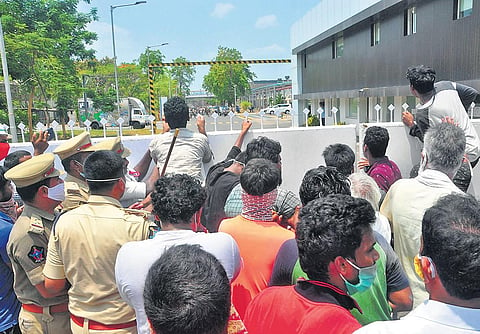

VISAKHAPATNAM: Simulation studies are still going on the extent of impact of vapours on people in affected villages, according to Prof S Bala Prasad, a noted environmental expert and chairman of the pollution committee constituted by the State government to study the gas leak impact at LG Polymers unit at RR Venkatapuram.
Speaking to TNIE here on Wednesday, he said during the study, which will be completed in five days, they will ascertain the concentration levels and the duration of time people inhaled vapours at different times in different villages.
He explained that they are conducting the study using dispersion models to know the ambient concentration of pollutants or toxins emitted from source.
This will help them get an idea about the levels of concentration at different times.
After collecting the data with the help of dispersion models they will analyse it and prepare a report on the extent of impact in the affected villages.
Admitting that there are several hazardous industries in the district, Bala Prasad said industrial units should follow all safety protocols and parameters and should deploy relevant trained experts to maintain critical equipment. If the industry follows them strictly, there will be no problem.
He recalled that LG Polymers has been functioning since 1961 and there was hardly any incident till the one happened on Thursday after partial lifting of lockdown. The experts from the industrial unit should have alerted people in the neighbourhood about the possible scenario during resumption of production activity. Or at least they should have informed the district administration about the possible details of the activity. But it seems they neither alerted people nor informed the district administration, he opined. Had the district administration been informed about it, it would have taken measures to minimize the losses, he added.
Bala Prasad stated that the inspector of factories department will have onsite and offsite disaster management plans. It will have documents with regard to possible scenario of disasters and the likely extent of the impact. The department officials will visit the hazardous industry once in three months to audit the safety of the industry. At least the department should have informed the administration about the hazardous chemicals in various factories in the district and their threat perception basing on the onsite and offsite disaster management plans. Whenever the systems relax, the situation goes worse, he rued.
Stating that there was geographical location disadvantage for Visakhapatnam, he said setting up pollution control equipment and following the guidelines by the industry will help in bringing down pollution. He found fault with the civic body and residents for contributing to the pollution as much as by the industries in the city. The city has large industrial units, therefore pollution was inevitable.
As per the Solid Waste Management policy, 2006, it was proposed to do away with dump yards, and the rules were changed in 2016. But still there are dump yards in the city. Pollution levels can be brought down only with the change in the mindset of people and also strict adherence to norms by the industries with regard to protection of environment, Bala Prasad asserted. He opined that zero accident rate was also a tough task as most of the accidents are happening either due to technical or manual errors. There should be thorough checks and training of industry personnel was the need of the hour, he stressed.
Dispersion models used for study
Prof S Bala Prasad, a noted environmental expert said that they are conducting the study using dispersion models to know the ambient concentration of pollutants or toxins emitted from source. This will help them get an idea about the levels of concentration at different times. After collecting the data with the help of dispersion models, they will analyse it and prepare a report